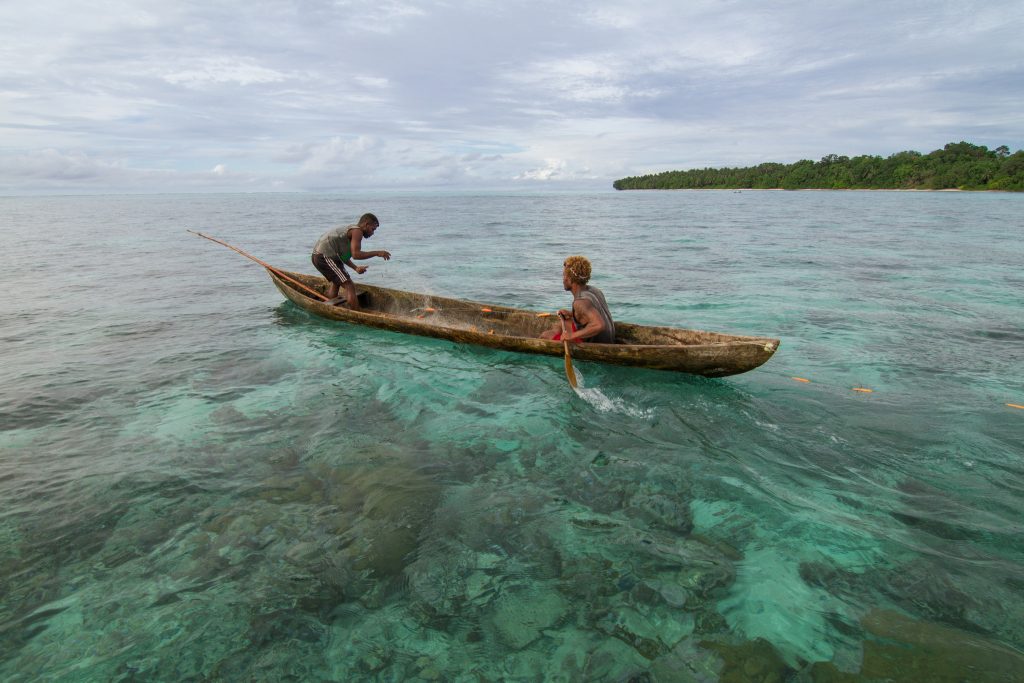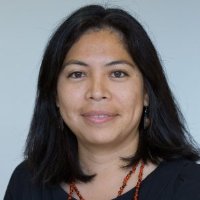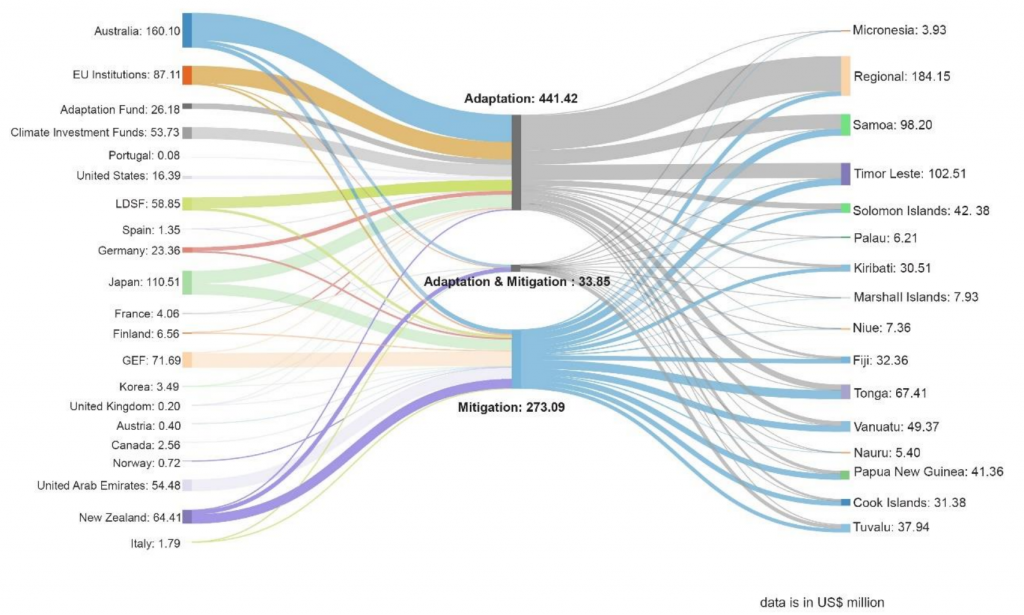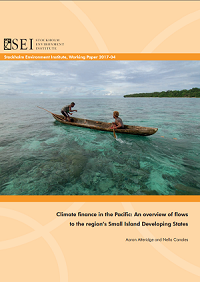
Pacific island states are among the world’s most vulnerable to climate change impacts. Given the urgent need to adapt, how effectively are climate finance flows helping Pacific states tackle adaptation?
The Stockholm Environment Institute’s recent working paper, Climate Finance in the Pacific: An Overview of Flows to the Region’s Small Island Developing States, analyzed climate finance between 2010 and 2014 (both mitigation and adaptation) for 15 small island developing states in the Pacific.
Analyzing the USD 748 million in official development assistance to the Pacific during this period, some of the report’s key findings include:
- 59 per cent of climate finance was for adaptation, while 36 per cent was for mitigation and 5 per cent was for both.
- 72 per cent of all climate finance was via bilateral development partners (note: this ratio may have since changed in more recent years, as the Pilot Program for Climate Resilience and the Green Climate Fund [GCF] have scaled up their support in the region since 2015).
- 46 per cent of adaptation finance went towards “creating an enabling environment,” which includes policy development and integrating climate change into national planning.
We spoke with the report’s co-author, Nella Canales, about lessons she has drawn from these findings, and how she thinks climate finance can be leveraged to meet the significant challenge of adapting to climate change.
During your study, what key differences did you find between bilateral and multilateral sources of climate finance for adaptation in the Pacific?
 Nella Canales: I think that there are a few differences between multilateral and bilateral funding. Not necessarily between adaptation and mitigation—we compared the policy objectives of both and there are not a lot of differences in terms of sources (bilateral or multilateral). The main differences that we found were that, first, bilaterals seem to be more flexible in that they can cover a wider range of sectors. Second, [multilaterals and bilaterals] do work with different intermediaries. Whereas multilaterals generally have a set list of institutions that they work with—for example, the Global Environment Facility only does work with a specific set of agencies—bilaterals have a wide variety of channels and can work with their own agency that is in the country or in the region, or they can work through non-governmental organizations, or directly with recipient country institutions, etc.
Nella Canales: I think that there are a few differences between multilateral and bilateral funding. Not necessarily between adaptation and mitigation—we compared the policy objectives of both and there are not a lot of differences in terms of sources (bilateral or multilateral). The main differences that we found were that, first, bilaterals seem to be more flexible in that they can cover a wider range of sectors. Second, [multilaterals and bilaterals] do work with different intermediaries. Whereas multilaterals generally have a set list of institutions that they work with—for example, the Global Environment Facility only does work with a specific set of agencies—bilaterals have a wide variety of channels and can work with their own agency that is in the country or in the region, or they can work through non-governmental organizations, or directly with recipient country institutions, etc.
I think it’s important to bear in mind that bilateral relationships that have been established between the two countries have much longer time frames than multilateral relationships because the multilateral climate funds are relatively new. I think there can be a lot of emphasis on applying to the funds, but we have to remember that they’re not the only ones who can provide funding for adaptation.

As countries develop financing strategies for their National Adaptation Plan (NAP) processes, a common concern has been finding sources of funding for implementation of adaptation actions prioritized through the NAP process. Based on your research, what kinds of opportunities did you see for bilateral funding to fill this gap in implementation funding?
NC: I think that because it is a bilateral negotiation, there is a better opportunity to engage in a completely different way with your donor through these long-term, more established relationships. I think there is the more opportunity for the country to set a group of priorities where they want to invest—they can be sectoral or sub-sectoral—and they can send those ideas to bilateral institutions. These processes are completely different from the multilateral ones.
And, of course, the multilateral institutions were established to have the same process for every single country. But while there are different ways for applying to bilateral institutions, there is only one way to apply for funding from multilateral institutions. And sometimes, unfortunately, the process for applying to multilaterals is quite complex; so complex, that we now have funding for readiness processes [to prepare to apply for funding].
We all understandably need to change some of our internal processes in our countries, but sometimes I think that some of our processes are so complicated that we need to spend a lot of money getting people ready to apply for funding. It’s a question that we sometimes forget to ask: if it’s so complicated [to apply] that we need to spend a year or two in order to be able to apply later on, then is there something maybe too complicated about the process?
We also need to spend some time trying to simplify those processes, and I think that, in that sense, the bilateral also offers this opportunity—if you as a country are interested in applying for a large-scale funding like the GCF can offer, then in the meantime, because it will take you a long time to get ready to apply for the GCF, you can always ask your development partners to support you—not only in the readiness process, but actually in investing in implementation.
I think that countries need to balance both [bilateral and multilateral funding] and not just focus on multilateral funds.
Is a large enough proportion of climate finance in the Pacific going toward funding implementation?
NC: Most of the funding in the Pacific for adaptation has been going to create an “enabling environment,” which means that it is going to support policies, it’s going to support mainstreaming processes. So this is where we have been spending much of the funding in the last five years, and we need to make an assessment of what actually has been achieved with that funding.
We need to make some sort of stocktake of what has been happening with that funding, and if we’re “not ready yet,” if the enabling environment is not enough, then we need to think about where we go from here. I think that climate change now has been going on for a while already, and funds are continuously going to create an enabling environment.
We don’t have that much time anymore, especially for adaptation. We also don’t have much time for mitigation. And we need to implement, and not just focus on an enabling environment.
How important is it for bilateral development partners and countries to coordinate their adaptation financing?
NC: I think that it’s very important that the countries, when they’re receiving funding for ‘A,’ and they know that they need funding for ‘A,’ ‘B’ and ‘C,’ that they ask for ‘B’ and ‘C.’ And ‘D.’

There is of course pressure on the bilateral development partners not to duplicate efforts, but this is also a shared responsibility with the country, which needs to make requests and be firm. And one of the ways to do that is to ask for transparency and access to information.
Part of our research is done with publicly available information. However, that’s why it’s interesting, and why people like it—it’s adding up numbers that are publicly available, but nobody does it!
It takes a research community to show this in a way that it’s aggregated, all of the donors in a region, and I think we need begin to use this information that is available.
There are different goals for different institutions:
- We, the research community, must support by providing this aggregated information.
- The development partners need to be willing to provide this information to do a very good job in tagging, in making their investment comply with all of the effectiveness criteria.
- Countries need to demand accountability from their development partners.
I think it’s a combination; everyone has a role in coordination.
Any opinions stated in this blog post are those of the author and do not necessarily reflect the policies or opinions of the NAP Global Network, its funders or Network participants.
Interested in joining the Network as a participant? Find out more.